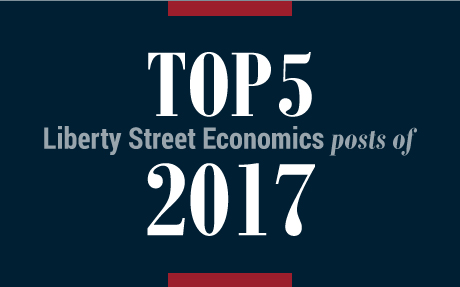Just Released: A Closer Look at Recent Tightening in Consumer Credit
Just Released: A Look at Borrowing, Repayment, and Bankruptcy Rates by Age

Household debt balances increased in the third quarter of 2018, a 17th consecutive increase. Total debt balances reached $13.51 trillion, a level more than 20 percent above the trough reached in 2013, according to the latest Quarterly Report on Household Debt and Credit from the New York Fed’s Center for Microeconomic Data. With today’s report we begin publishing a new set of charts that depict debt and repayment outcomes by the age of the borrower. The report and this analysis are based on the New York Fed Consumer Credit Panel (CCP), a 5 percent sample of anonymized Equifax credit reports. Here we’ll highlight three of the new charts.
Just Released: Are Employer‑to‑Employer Transitions Yielding Wage Growth? It Depends on the Worker’s Level of Education

The rate of employer-to-employer transitions and the average wage of full-time offers rose compared with a year ago, according to the Federal Reserve Bank of New York’s July 2018 SCE Labor Market Survey. Workers’ satisfaction with their promotion opportunities improved since July 2017, while their satisfaction with wage compensation retreated slightly. Regarding expectations, the average expected wage offer (conditional on receiving one) and the reservation wage—the lowest wage at which respondents would be willing to accept a new job—both increased. The expected likelihood of moving into unemployment over the next four months showed a small uptick, which was most pronounced for female respondents.
Just Released: Cleaning Up Collections

Household debt balances continued their upward trend in the second quarter, with increases in mortgage, auto, and credit card balances, according to the latest Quarterly Report on Household Debt and Credit from the New York Fed’s Center for Microeconomic Data. Student loans were roughly flat, a typical seasonal pattern in the second quarter. The Quarterly Report contains summaries of the types of information that is covered in credit reports, sourced from the New York Fed Consumer Credit Panel (CCP). The CCP is based on anonymized Equifax credit reports and is the source for the analysis provided in this post, which focuses on an area that until recently has received little attention: collections accounts.
Mixed Impacts of the Federal Tax Reform on Consumer Expectations

The Tax Cuts and Jobs Act of 2017 changed the tax brackets, tax rates, credits and deductions for individuals and similarly altered corporate tax rates, deductions and exclusions. In this post, we examine whether the reform has shifted individuals’ expectations about their financial situation and the macroeconomic outlook. We also ask whether households have already started to adjust their behavior in line with their expectations. In order to answer these questions, we use novel data from a special module of the New York Fed’s Survey of Consumer Expectations (SCE) fielded in February 2018 to a nationally representative sample of heads of households.
Just Released: New York Fed Press Briefing Highlights Changes in Home Equity and How It’s Used

Andrew Haughwout, Donghoon Lee, Joelle Scally, and Wilbert van der Klaauw At a press briefing this morning, economists at the New York Fed focused on the evolution of housing wealth and its use as collateral. Their comments came in connection with the Center for Microeconomic Data’s release of its Quarterly Report on Household Debt and […]
How Will the New Tax Law Affect Homeowners in High Tax States? It Depends

The Tax Cuts and Jobs Act of 2017 (TCJA) introduces significant changes to the federal income tax code for individuals and businesses. Several provisions of the new tax law are particularly significant for the owner-occupied housing market. In this blog post, we compare the federal tax liability and the marginal after-tax cost of mortgage interest and property taxes under the old and new tax codes for a wide range of hypothetical recent home buyers in a high tax state. We find that impacts vary substantially along the income/home price distribution.
Landing a Jumbo Is Getting Easier

Andreas Fuster, James Vickery, and Akhtar Shah The United States relies heavily on securitization for funding residential mortgages. But for institutional reasons, large mortgages, or “jumbos,” are more difficult to securitize, and are instead usually held as whole loans by banks. How does this structure affect the pricing and availability of jumbo mortgages? In this […]
Just Released: Great Recession’s Impact Lingers in Hardest‑Hit Regions

The New York Fed’s Center for Microeconomic Data today released our Quarterly Report on Household Debt and Credit for the fourth quarter of 2017. Along with this report, we have posted an update of state-level data on balances and delinquencies for 2017. Overall aggregate debt balances increased again, with growth in all types of balances except for home equity lines of credit. In our post on the first quarter of 2017 we reported that overall balances had surpassed their peak set in the third quarter of 2008—the result of a slow but steady climb from several years of sharp deleveraging during the Great Recession.
The Fed’s Balance Sheet, Night Lights, and the Other Top LSE Posts of 2017

In the spirit of this season of year-end lists of accomplishments, Liberty Street Economics offers a roundup of our most viewed posts. Our readers continued to gravitate toward timely, topical posts; our most popular explained how the Fed manages its enlarged balance sheet—a major focus of the FOMC, Congress, markets, and economists. Prompted by reader questions in response to their first post, the authors also penned a follow-up post. Another hit this year described an innovative indicator of economic growth—night light intensity measured via satellite—and used it to fact-check official Chinese growth estimates.











 RSS Feed
RSS Feed Follow Liberty Street Economics
Follow Liberty Street Economics